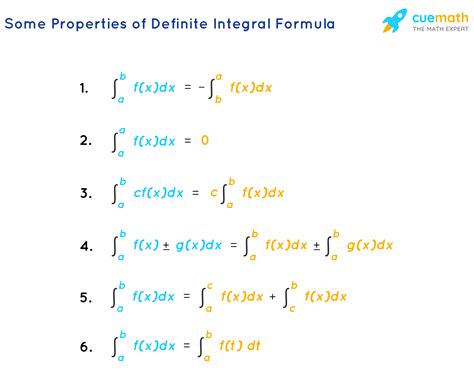Introduction
Integrals, represented by the symbol ∫, play a pivotal role in various fields of mathematics and science. They provide a means to calculate the area under a curve, volumes of solids, and other complex mathematical concepts. Understanding and utilizing integrals effectively can open up a world of applications and problem-solving techniques.

1. Definition and Notation
The integral of a function f(x) over an interval [a, b] is defined as the area under the curve y = f(x) between the points x = a and x = b. It is denoted by:
∫[a, b] f(x) dx
2. Types of Integrals
Indefinite Integrals
Indefinite integrals, also known as antiderivatives, represent the family of functions whose derivatives are the original function. They are denoted by:
∫ f(x) dx
Definite Integrals
Definite integrals calculate the exact area under a curve over a specific interval. They are denoted by:
∫[a, b] f(x) dx
3. Properties of Integrals
Fundamental Theorem of Calculus
The Fundamental Theorem of Calculus establishes a powerful connection between differentiation and integration:
If F(x) is the antiderivative of f(x), then:
∫[a, b] f(x) dx = F(b) – F(a)
Linearity
Integrals are linear operators, meaning they obey the following properties:
∫[a, b] (f(x) + g(x)) dx = ∫[a, b] f(x) dx + ∫[a, b] g(x) dx
∫[a, b] cf(x) dx = c∫[a, b] f(x) dx
Substitution Rule
The substitution rule allows for integrals of the form ∫f(u) du to be evaluated in terms of x, where u = g(x).
4. Applications of Integrals
Area Under a Curve
One of the most fundamental applications of integrals is to compute the area under a curve. This is particularly useful in fields such as engineering and physics, where understanding the distribution of forces or energy is critical.
Volume of Solids
Integrals can be used to determine the volume of various solids, including pyramids, cones, and spheres. This has extensive applications in architecture, construction, and fluid dynamics.
Work and Energy
The work done by a force over a distance can be calculated using integrals. Similarly, the kinetic energy of an object can be expressed in terms of its velocity through integration.
Probability and Statistics
Integrals form the backbone of probability theory and statistics. They are used to calculate probabilities, determine expected values, and analyze distributions.
5. Pain Points and Motivations
Pain Points:
- Difficulty grasping the concept of integration
- Lack of clear understanding of the Fundamental Theorem of Calculus
- Challenges in applying integrals to real-world problems
Motivations:
- Overcoming obstacles in mathematics and science
- Enhancing research and analysis capabilities
- Gaining an edge in the competitive job market
6. Step-by-Step Approach to Solving Integrals
Indefinite Integrals
- Identify the antiderivative of the function (if possible)
- Apply the constant of integration
Definite Integrals
- Find the indefinite integral of the function
- Evaluate the indefinite integral at the upper and lower bounds
- Subtract the value at the lower bound from the value at the upper bound
7. Pros and Cons of Using Integrals
Pros
- Allows for precise calculation of areas, volumes, and other mathematical concepts
- Provides a powerful tool for solving complex problems in science and engineering
- Enables the analysis and interpretation of data
Cons
- Can be challenging to grasp and apply correctly
- May require advanced mathematical skills
- Can become computationally intensive for complex functions
8. 1 y 2 Integral: A Novel Application
The 1 y 2 integral, denoted by ∫y² dx, represents a function whose graph is a parabola. This integral has unique applications in:
Parabolic Approximation:
By approximating curves with parabolas, the 1 y 2 integral can be used to estimate areas and volumes with greater accuracy.
Fluid Dynamics:
The 1 y 2 integral is used to analyze the flow of fluids in pipes and channels, providing insights into velocity profiles and pressure distributions.
9. Useful Tables
Table 1: Common Integrals
| Function | Integral |
|---|---|
| x^n | x^(n+1)/(n+1) + C |
| e^x | e^x + C |
| sin(x) | -cos(x) + C |
| cos(x) | sin(x) + C |
| tan(x) | -ln( |
Table 2: Properties of Integrals
| Property | Definition |
|---|---|
| Linearity | ∫[a, b] (f(x) + g(x)) dx = ∫[a, b] f(x) dx + ∫[a, b] g(x) dx |
| Constant Multiple | ∫[a, b] cf(x) dx = c∫[a, b] f(x) dx |
| Chain Rule | ∫f(u) du = ∫f(g(x)) g'(x) dx |
| Substitution Rule | ∫[a, b] f(g(x)) g'(x) dx = ∫[g(a), g(b)] f(u) du |
Table 3: Applications of Integrals
| Application | Use |
|---|---|
| Area Under a Curve | Computing the area between a function and the x-axis |
| Volume of Solids | Determining the volume of 3D objects |
| Work and Energy | Calculating the work done by a force or the kinetic energy of an object |
| Probability and Statistics | Analyzing probability distributions and expected values |
Table 4: Pain Points and Motivations in Integrals
| Pain Point | Motivation |
|---|---|
| Difficulty understanding the concept | Overcoming obstacles in mathematics and science |
| Lack of clarity in the Fundamental Theorem of Calculus | Enhancing research and analysis capabilities |
| Challenges in applying integrals to real-world problems | Gaining an edge in the competitive job market |
10. Conclusion
Understanding and utilizing integrals is a critical aspect of mathematics and science. By mastering the concepts, properties, and applications of integrals, individuals can unlock a wealth of opportunities for problem-solving and innovation. With the advent of new applications, such as the 1 y 2 integral, the potential of integrals continues to expand, making them an indispensable tool for tackling complex challenges.
